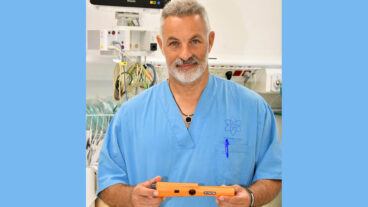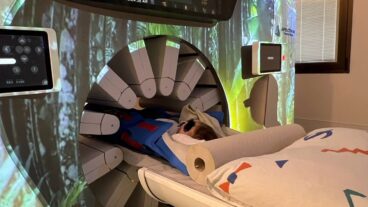A little levity can go a long way, especially if you’re a woman trying to conceive via in-vitro fertilization (IVF). That’s the lesson that’s been gleaned from a first-of-its kind study conducted in Israel that showed that using humor to alleviate the stress of the patients almost doubles their chances of conceiving from the treatments.
A team led by fertility expert Dr. Shevah Friedler at the Assaf Harofeh Medical Center studied 186 women aged 25 to 40 over 10 months, all of whom were undergoing embryo transfer treatment. While half were simply given the treatment and nothing else, the other group was entertained by a clown for up to 15 minutes as they recuperated in bed after the treatment.
The results? 33 of the women who ‘clowned’ around became pregnant, compared to only 18 women in the control group. For the 60,000 American women who undergo IVF treamtent annually, the message is: don’t worry, be happy.
For Friedler, the project was synthesis of his two passions – theater and medicine.
“I’m trained as both a doctor and a mime,” Friedler told ISRAEL21c with a chuckle. “After I finished medical school, I attended the Jacques Lecoq School of Mime and Theater in Paris. I wanted to be a professional in both fields. I had dabbled in mime her, but I guess I was good enough to receive a scholarship from the French government, and I studied there for two years.”
For the last two years, Friedler has been in charge of the clown therapy project at Assaf Harofeh, a program that began in 2000. His resident funnyman is Shlomi Algosi, a clown by profession, who took a course on clown therapy in 1994.
Based on an American program (popularized by the film Patch Adams), the goal is to speed patients’ recovery by making them laugh. Professionals from New York’s Big Apple circus spent time in Israel teaching Algosi and other participants not just how to be a clown, but how to relate to and tune in to the patients’ feelings.
For Algosi, that wasn’t too difficult. He decided to enter the field after recalling how lonely and afraid he was as a child he was hospitalized for months after contracting polio. Since launching the Assaf Harofe program, Algosi and Friedler have provided entertainment and hope for hundreds of young patients, and have trained other medical professionals, including doctors and nurses, how to do likewise.
“We’ve mostly treated children, but we’ve also worked with some adults – in the dialysis unit,” said Algosi.
Despite the proven successes that clown therapy has had on children, neither Friedler nor Algosi had ever attempted using it on a patient involved in a complex procedure such as IVF. But according to Friedler, the intersection of the two was inevitable.
“It combines my capacities for theater and mime with my background as a physician. It was only natural that I found a way to make use of clowning within my specialty field – treating infertility patients,” he said.
It was a natural match for other reasons as well, he explained.
“Characteristically, IVF patients are under a lot of stress. It’s quite obvious – but not enough research has been done in the field – that there’s a connection between health and humor. People use humor naturally – if we’re in a dangerous or stressful situation,” said Friedler.
So he and Algosi set out to develop a program with the goal of seeing if humor could reduce the stress and anxiety of the IVF treatment, particularly after the embryo had been transferred to the woman’s womb. Their challenge was to adopt what was essentially a children’s program for adults.
“We had to devise a different concept for this – with children, we used red-nosed clowns,” explained Algosi. “But for IVF patients, a clown can remind them of children – the reason they’re here in the first place. We had to be more sensitive.
“We tried to come up with an image that provides service – a waiter, an entertainer… in the end, we chose to use a chef,” he told ISRAEL21c. “We then devised an act, consisting of some sketches, some magic and a few bits of slapstick. All together about 10-15 minutes.”
Instead of the red nose, Algosi wears a striped vest.
“He comes in to the patient lying in bed, and asks ‘did you order steak flambé or chocolate mousse?’ Now this is a public hospital with public hospital food, so this ironic juxtaposition breaks the ice,” said Friedler. “The response from the women was wonderful.”
But even with a positive reaction, Friedler was unprepared for the results. In fact, the increased birth rate was not even part of the study.
“Frankly, what we expected to find was a difference in psychological characteristics among the patients undergoing the therapy and those not,” said Friedler. “Together with the Gertner Institute at Tel Hashomer Medical Center, we designed a very nice questionnaire that the patients filled out.”
The researchers did find a big difference in the psychological characteristics between the patients who underwent the clown therapy and those that didn’t. But they also found something that they never expected. The conception rate for the women who were entertained by the clown jumped from 20 to 35 percent.
“We were very surprised by the results. And frankly, I can’t explain it,” said Friedler.
Hepresented the findings before the Israel Fertility Association meeting in May and submitted an abstract to the European Society of Human Reproduction and Embryology (ESHRE) that met this month in Geneva, resulting in a high profile response from colleagues and the media.
“We’re planning on attending the American Society for Fertility conference in October. And we’re continuing the project with the aim of enrolling 120 women in each arm of the program,” said Friedler.
For Algosi, that’s not a problem, as he finds himself motivated by both the performance and the results.
“Each time I perform, it’s like starting from scratch,” he said.
“My wife jokes to me that she didn’t know she had married someone with magical powers that can help bring children into the world, ” said the father of two. “But that’s really what we’ve succeeded in doing.”












